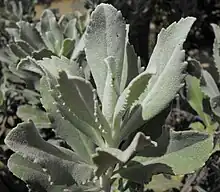| Hazardia detonsa | |
|---|---|
 | |
| Scientific classification | |
| Kingdom: | Plantae |
| Clade: | Tracheophytes |
| Clade: | Angiosperms |
| Clade: | Eudicots |
| Clade: | Asterids |
| Order: | Asterales |
| Family: | Asteraceae |
| Genus: | Hazardia |
| Species: | H. detonsa |
| Binomial name | |
| Hazardia detonsa | |
| Synonyms[1] | |
| |
Hazardia detonsa is a rare species of shrub in the family Asteraceae known by the common name island bristleweed.[2] It is endemic to the Channel Islands of California, having been found on 4 islands (Santa Rosa, Santa Cruz, West Anacapa, and Middle Anacapa).[3]
Hazardia detonsa is a bushy shrub reaching 60 centimetres (24 in) to 2.5 metres (8 ft 2 in) in height. It has densely woolly, glandular herbage of thick, serrated, oval-shaped leaves up to 14 centimetres (5.5 in) long. At the ends of its whitish stems it produces bell-shaped flower heads each about a centimeter long. Each flower head has several rows of white woolly phyllaries and an open end revealing disc florets and longer protruding ray florets. The florets are yellow and may age to red or purple.[4] The main threat to this species on Santa Cruz Island was the presence of feral Santa Cruz sheep. The sheep have been removed, allowing the plant to begin its recovery there.
References
- ↑ The Plant List, Hazardia detonsa (Greene) Greene
- ↑ "Hazardia detonsa (Greene) Greene Island bristleweed". USDA. Plants Profile. Retrieved March 25, 2008.
- ↑ Calflora taxon report, University of California, Hazardia detonsa (E. Greene) E. Greene, Northern islands hazardia, island bristleweed, island hazardia, northern island haplopappus
- ↑ Flora of North America, Hazardia detonsa (Greene) Greene, 1887. Island bristleweed
External links
- Calflora Database: Hazardia detonsa (Island bristleweed, Northern island haplopappus, Northern islands hazardia)
- Jepson eFlora (TJM2) treatment of Hazardia detonsa
- UC CalPhotos gallery of Hazardia detonsa images